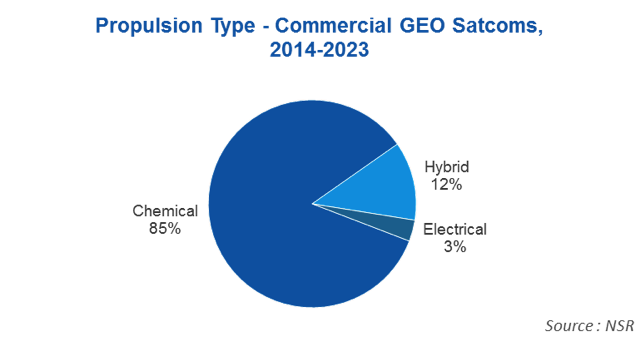Time is Money for Electric Propulsion
Aug 6, 2014 by
Stéphane Gounari, NSR
Since the March 2012 deal between Boeing, SpaceX, ABS
and Satmex, no full electric propulsion (EP) GEO Satcom
had been ordered. July 2014 however marked the end of
this dry period with the procurement of SES-12,
Eutelsat-172B and the announcement, by India-based
Aniara, of the procurement of two EP satellites.
These deals illustrate different aspects of the EP
value-proposition. SES-12 will have a mass of 5,300 kg
and a very large payload featuring 54 wide-beam
transponders (36 MHz equivalents) and more than 80
spot-beams. In parallel, its mass means it could be
launched on Falcon-9. By stacking a very large payload
on a 5,300 kg satellite,
SES is truly leveraging every
aspect of EP.
It may use a cheaper launcher, reducing CAPEX, while
getting a very large payload on one satellite,
maximizing the satellite’s capability, thus increasing
its revenue generation capability.
Eutelsat-172B illustrates the same logic. With a mass
of 3,500 kg it will be a fit for the low seat on
Ariane-5,
whose price was recently considerably lowered.
But at the same time, the satellite will carry three
payloads totaling 50 physical transponders and a 1.8
Gbps HTS payload.
In comparison, Aniara’s project is more similar to
Boeing/SpaceX/ABS/Satmex deal. With a unit mass of 1,000
kg, they will each carry around 15 transponders and are
baselined for a launch on GSLV. This project is clearly
focused on launch cost savings but at the expense of
satellite capabilities. Of note, Aniara’s satellites
will be the first GEO satellites manufactured by Dauria
Aerospace, and the GSLV is currently an unreliable
launch vehicle whose next version is still in
development.

The deals illustrate that the value-proposition of EP
GEO satcom is improving as reliability concerns are
addressed, but certain issues will not go away:
- Time is Money: An EP GEO satellite
will take months to reach its destination (4 months
for Eutelsat-172B), and this has a cost: From the
cost to monitor the satellite for months of
maneuvering to the interest on the project
investment as revenue generation is delayed.
- Lack of Reactiveness: Given the
orbit-raising time, an EP satellite is not wholly
reactive, which is a no-go when it comes to
unplanned replacement satellites. This is why EP
will primarily be used for planned replacements.
- Opportunity cost: For extension
projects, addressing new markets, the longer delay
before the satellite is operational means that some
revenues will be lost, and in some cases this could
also give a head-start to a competitor (space or
terrestrial). It will also be an issue for
replacement satellites as they usually address a few
new markets as well.
Bottom Line
As indicated in NSR’s
Satellite Manufacturing and Launch Services, 4th
Edition, electric propulsion for GEO Satcom has
value only when associated with a launch vehicle, be it
to save on costs (such as Aniara satellites), to
maximize the payload within a certain mass-range or to
do both at the same time (such as SES-12 and
Eutelsat-172B). Therefore, the value of EP is entirely
related to the launch services supply, in terms of mass
capability and price; Satellite Operators compare the
negative aspects of an EP-based architecture to the
gains. In the next few years, bigger launch vehicles
such as the Angara-5, Ariane-5ME and Falcon-Heavy will
become operational and will feature lower costs per kg
than today’s launchers. When this happens, the value of
EP will be considerably impacted.
This is why, despite the recent announcements, NSR
does not expect full EP to represent a large share of
the market for the next 10 years.